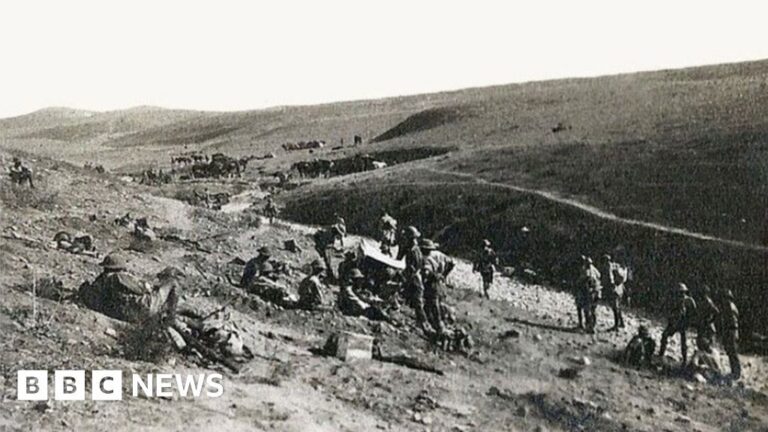Image source, Getty Images
A memorial to Welsh soldiers stands at Mametz Wood in France
This weekend, people across Wales will meditate on the words of First World War poet John McCrae: “In the fields of honor the poppies blow.”
However, for many people commemorating their fallen Welsh, neither poppies nor Flanders have much resonance.
Up to 40% of Welsh soldiers served in other theaters of war and never set foot in Belgium or France.
The 53rd (Welsh) Division, mainly from mid and north Wales, saw action in the Mediterranean and the Middle East.
Yet while the 38th (Welsh) Division is commemorated with a sculpture of a Welsh dragon at Mametz Wood in France, no such tribute exists for the men of the 53rd.
Historian Nia Griffiths, from Llanidloes, Powys, covered what she calls “the forgotten war” as part of her master’s thesis.
She discovered that of the 114 names on the city’s war memorial, 35 died in battle in Gallipoli and Gaza, but also in Egypt, Mesopotamia and Thessaloniki, Greece.
She said: “It is true to say that 68 of the dead were killed on the Western Front and they should rightly be honoured, but around 40% died in the Middle East, and that is surely a high enough percentage so that the stories of these men are also taken into account. heard?”
She thinks official commemorations can be “a bit lazy” because every Remembrance Sunday “we say they will never be forgotten”, but Ms Griffiths believes a large proportion of the men are forgotten.
Many Welsh soldiers never set foot in Europe to fight
She added that in addition to the death toll, in terms of numbers the impact on rural Welsh communities was often even more pronounced.
“In all four parishes of Llanidloes, many men volunteered at the start of the war,” she said.
“They were the first to enthusiastically embrace Kitchener’s Pals Battalions, perhaps because there was a stronger community spirit than in the industrialized south, perhaps because the work was not as abundant or financially rewarding in mid and north Wales, but the effect was that often entire generations of rural towns and villages were wiped out.”
Sian Nicholas, professor of modern British history at Aberystwyth University, said the situation was very similar in her town.
As part of a Heritage Lottery Fund program to mark the centenary of the First World War in 2014, she created an interactive map of the approximately 1,000 Aberystwyth servicemen known to have taken part in the action and the locations where they fought.
She said she was surprised by the results.
“Yet every time I teach schoolchildren, or even college students, and I ask them the first thing that comes to mind when they think of the First World War, almost all of them answer: mud , trenches, poppies, etc. mentions sand, camels or flies.
Image source, Nia Griffiths
Llanidloes historian Nia Griffiths says entire generations of rural towns were wiped out in the ‘forgotten war’.
Retired journalist Rhys David, from Cardiff, has written an account of his father’s wartime experiences, based on his letters home, called Tell Mum Not to Worry.
Dewi David was only 17 when he lied about his age to volunteer in 1915.
As a postal worker he was posted to the Royal Engineers, fighting with the 53rd Division, to install vital telegraph and telephone systems.
He spent the agonizing winter of 1915 trying to hold on to Gallipoli, during an extremely difficult campaign.
‘World War
Rhys David said: “I don’t think we should look at this in purely Welsh terms – as a story of south versus mid and north Wales – Dewi was from Cardiff, and even then he felt the injustice of the forgotten war. just as bitterly as the troops you speak of in Llanidloes.
“I think the ‘Forgotten War’ is something that all of Britain is guilty of, not just us here in Wales.”
He said that initially his letters were “bright and airy”, but by 1918 they increasingly painted a picture of him being fed up.
Professor Nicholas said: “We call it the First World War, but our focus is still on a hundred square kilometers in the north of France.
“If we are ever to properly understand the conflict, we must appreciate the truly global aspects of it and ensure that this is better reflected in our school curricula.”


